Messier Monday: The Galaxy at the Head-of-the-Chain, M84
The core of the nearest great galaxy cluster holds a glorious sight unlike any other.
“Man must rise above the Earth, to the top of the atmosphere and beyond, for only thus will he fully understand the world in which he lives.” –Socrates
Each week on Messier Monday, we take an in-depth look at one of the 110 deep-sky wonders that make up the Messier Catalogue. Compiled by Charles Messier during the 18th Century, these fixtures in the night sky were catalogued to avoid confusion with potential new comets, but are now representative of the brightest, most easily (and spectacularly) viewed nebulae, star and globular clusters, and galaxies from our vantage point here on Earth.
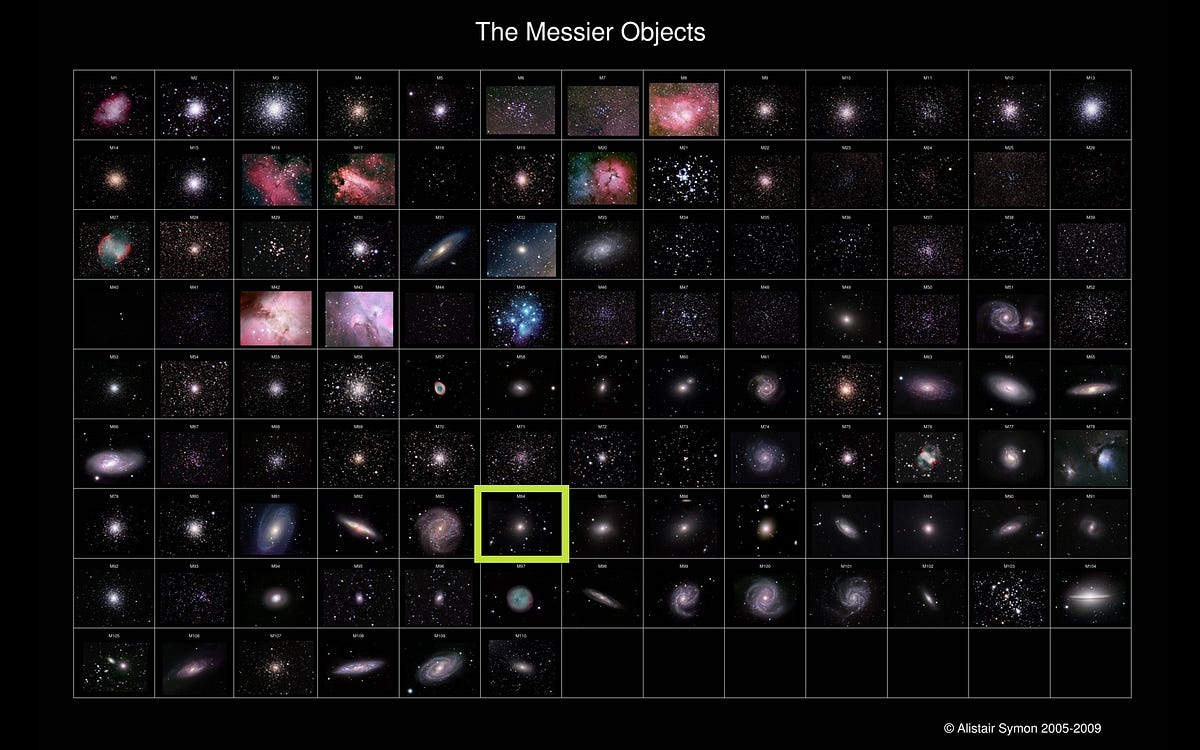
As both the June solstice and a new Moon approach, our nearest galaxy cluster — the Virgo Cluster — consisting of around 2,000 galaxies and an unequaled fifteen Messier objects, makes a perfect observing target for motivated skywatchers. And if you can find the gravitational center of this cluster, a treasure trove of galactic riches awaits you, with Messier 84 leading the way. Here’s how to find it.
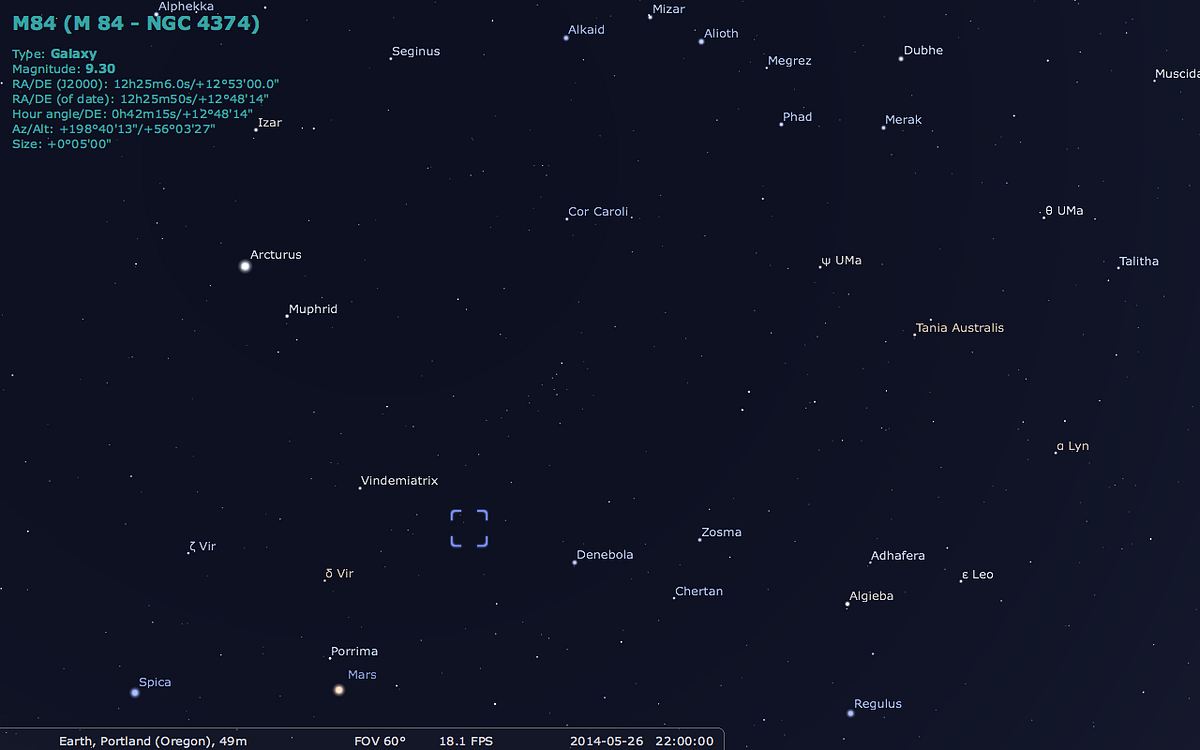
In the Northern Hemisphere, the Big Dipper is the most recognizable pattern of stars, with the prominent constellation of Leo not only lying “below” the dipper (about 40° to the South), but easily visible to observers on all continents except Antarctica. If you can find the two brightest stars in Leo — Regulus and the somewhat fainter Denebola — the imaginary line connecting them will lead you, if you extend it, towards the prominent (although slightly dimmer) Vindemiatrix.
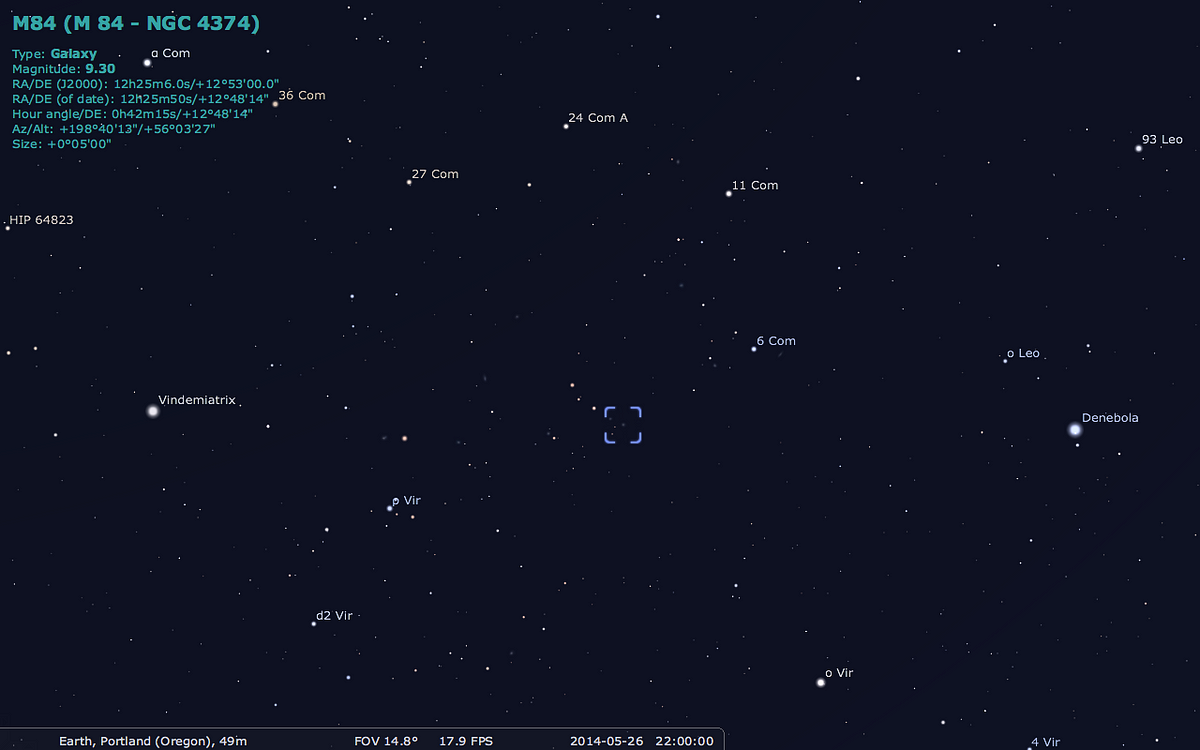
A large number of galaxies can be found in this region of space, as the Virgo Cluster is close enough — about 55-to-60 million light-years away — that its galaxies extend out for many degrees in all directions. But if you’re looking for the very core of the Virgo Cluster, you’ll want to head about halfway between Denebola and Vindemiatrix right along that imaginary line connecting them.
If you want a little help finding Messier 84, the naked-eye stars 6 Comae Berenices and ρ Virginis lie on either side of that imaginary line, and where that imaginary line and the Denebola-Vindemiatrix line intersect is where you should point your telescope.
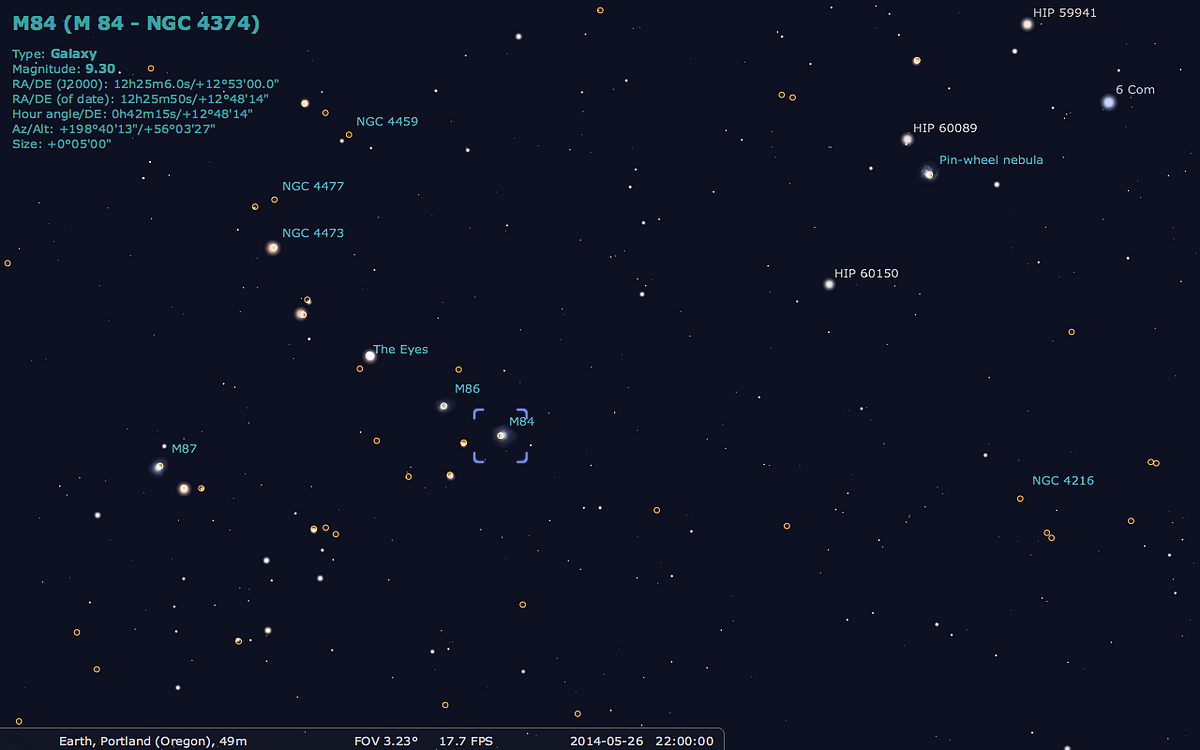
Because just a little over 2° away from ρ Virginis lies not only Messier 84, but a whole slew of galaxies, including a number of very prominent ones that branch off in a chain. In fact, this chain has a name — Markarian’s chain — and is one of the most targeted astrophotography sights in all the night skies. And to those with exceptional equipment, many more galaxies will be revealed than just the obvious ones in the chain!
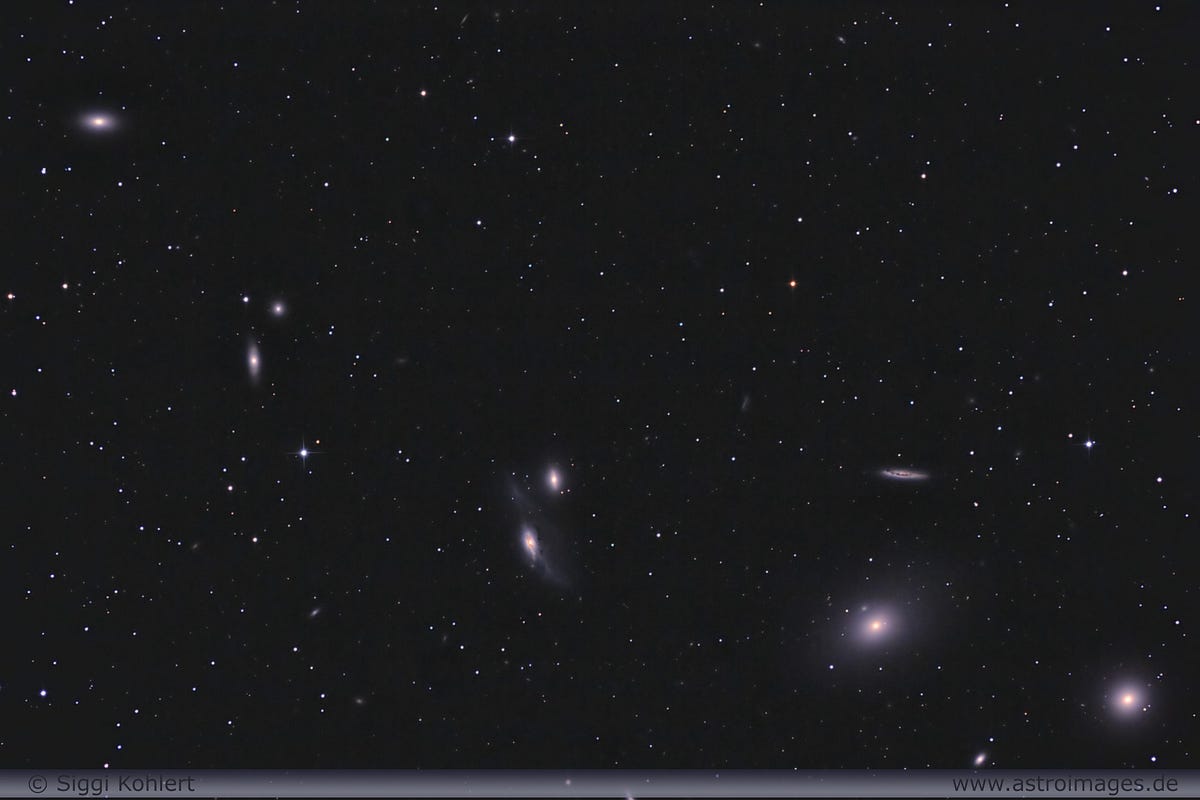
Although galaxies often line up just by coincidence, at least seven of these galaxies appear to move coherently, with Messier 84 — the big lenticular galaxy on the end (at the right, above) — being the lone exception! This galaxy wasn’t the first roughly spherical, giant elliptical that Messier encountered, describing it as such:
Nebula without star, in Virgo; the center it is a bit brilliant, surrounded with a slight nebulosity: its brightness & its appearance resemble that of those in this Catalog, No.s 59 & 60.
But this island Universe tells a unique story all on its own.
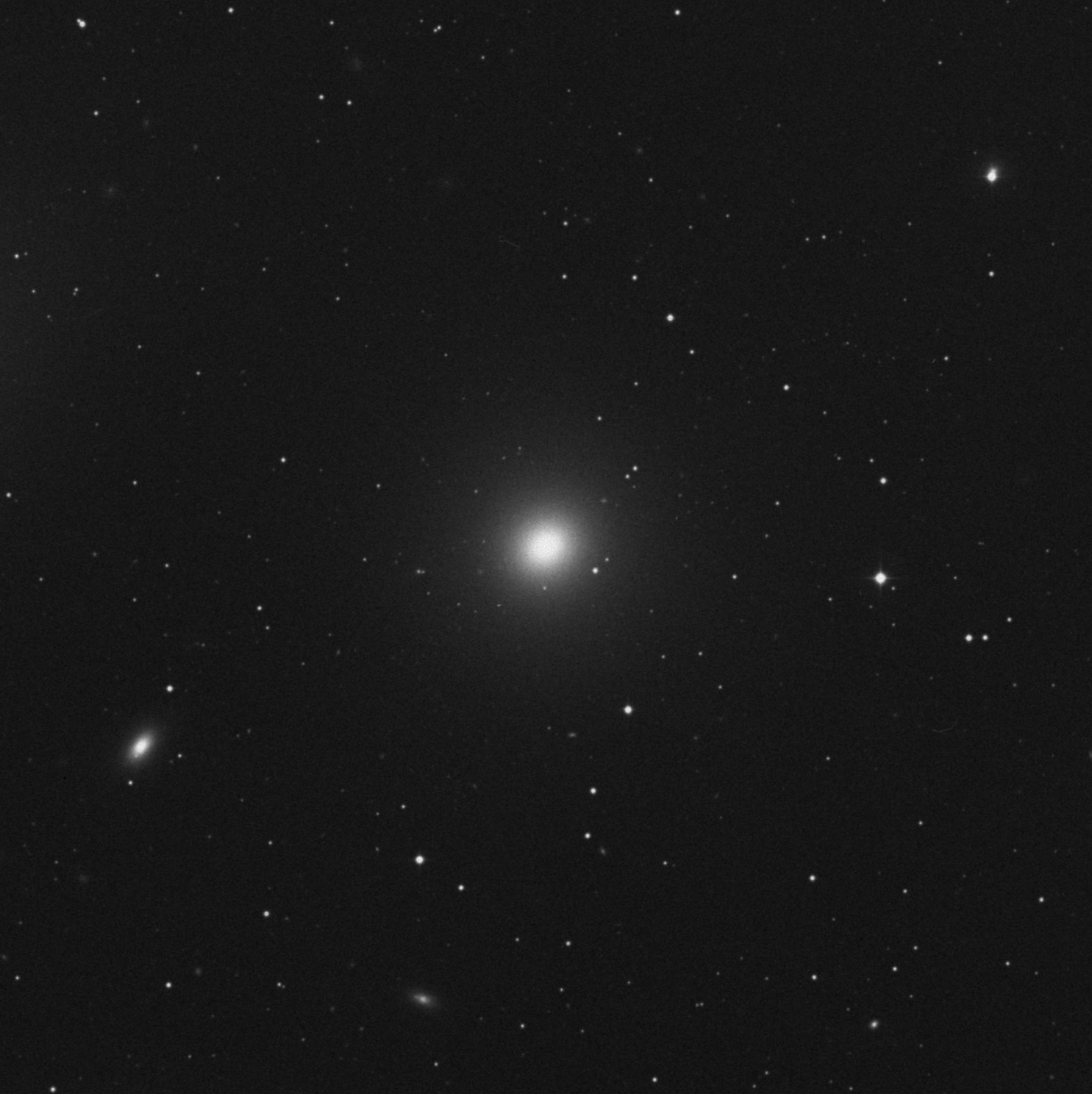
While the giant elliptical next to it — Messier 86 — is the most blueshifted of all Messier objects, moving towards Earth at around 400 km/s, Messier 84 is redshifted at 1000 km/s, moving in step with the majority of the Virgo Cluster. And while many of the galaxies nearest to it are highly ellipsoidal, this is a very spherical one, classified as an E1 galaxy. (Only the class E0 is more perfectly symmetrical.)
And yet, there’s a rich, fascinating story in here that isn’t normal for ellipticals at all!
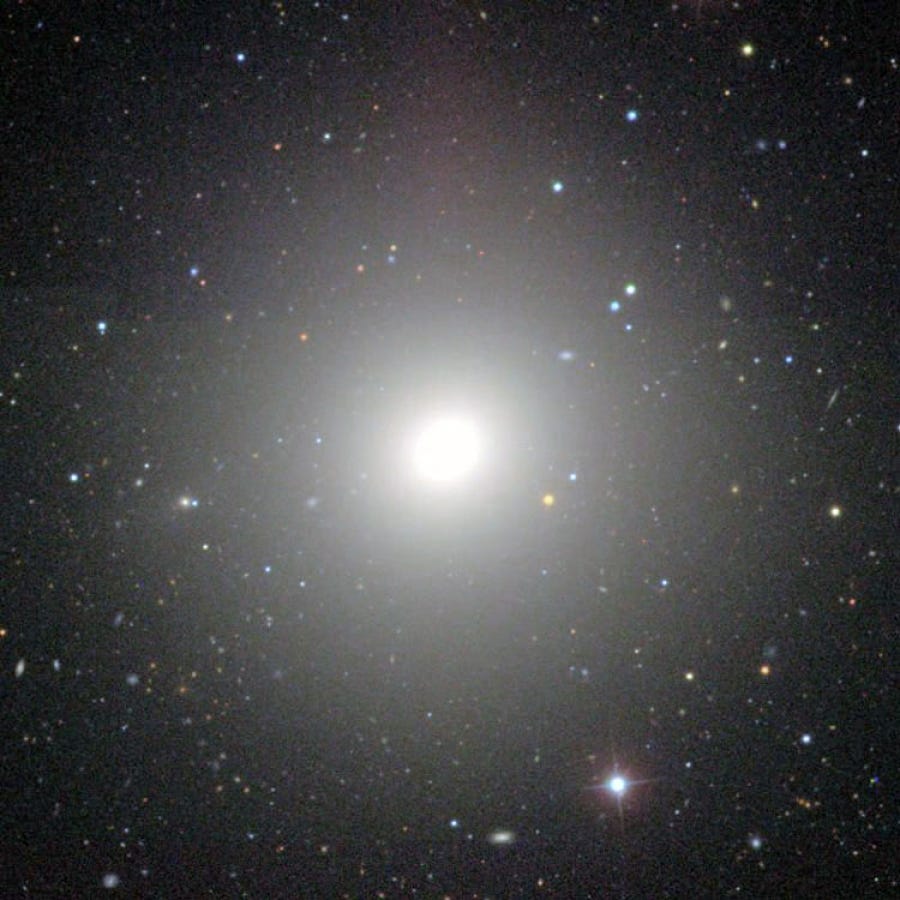
In standard, visible light, you might not be able to see anything out of the ordinary. But if you know what specific filters to look in, it turns out that there are some actually prominent dust features that block the light from the inner region of this galaxy. And these dust lanes look suspiciously like the ones we’re used to seeing in spiral and lenticular galaxies. Take a look at what the old WFPC2 instrument aboard Hubble was able to uncover!
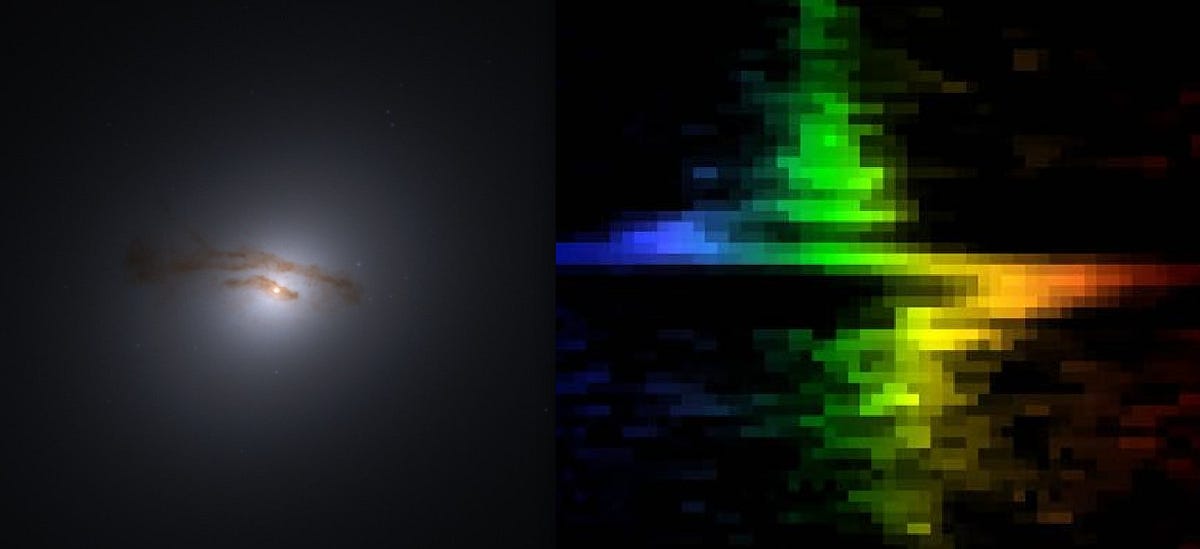
That disk actually rotates very rapidly, something that Hubble was able to spectroscopically observe (at right), telling us something critical just from the Keplerian orbits inside: there must be an extremely concentrated mass source at the center that weighs in at 1.5 billion Suns; such a thing could only be a supermassive black hole!
But there’s more! We can look in the radio, as supermassive black holes, when they accelerate gas, tend to produce bipolar radio lobes. If that’s what we’ve really got here, we should see some huge ones.
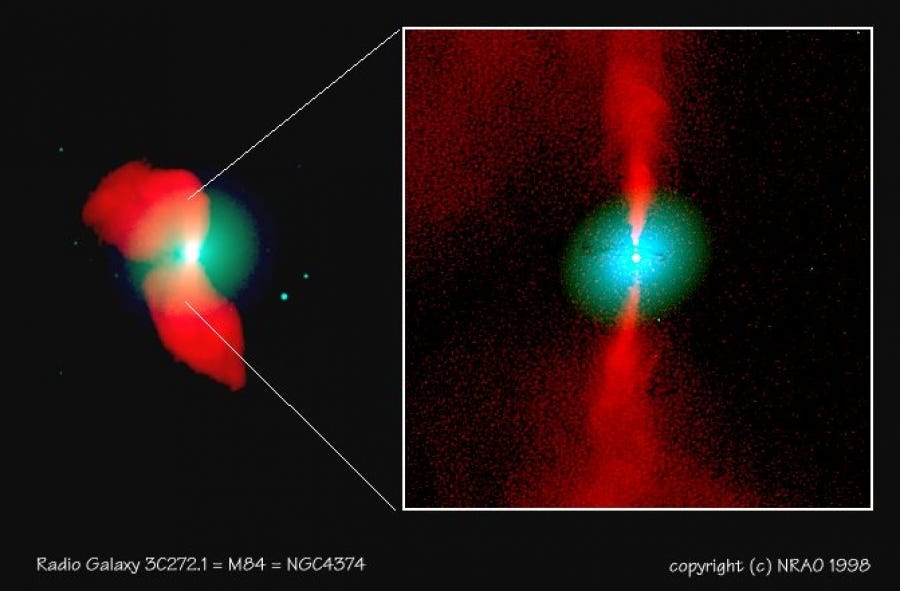
No problem there. In addition to that, there are huge X-ray emissions coming from this galaxy as well. Not only from the center, but from point sources that are most consistent with accreting black hole binaries in this halo of the galaxy.
Check out the composite below, using data from the SDSS (visible; in yellow), the VLA (radio; in red) and the hot gas from Chandra X-ray Observatory (X-ray; in blue).
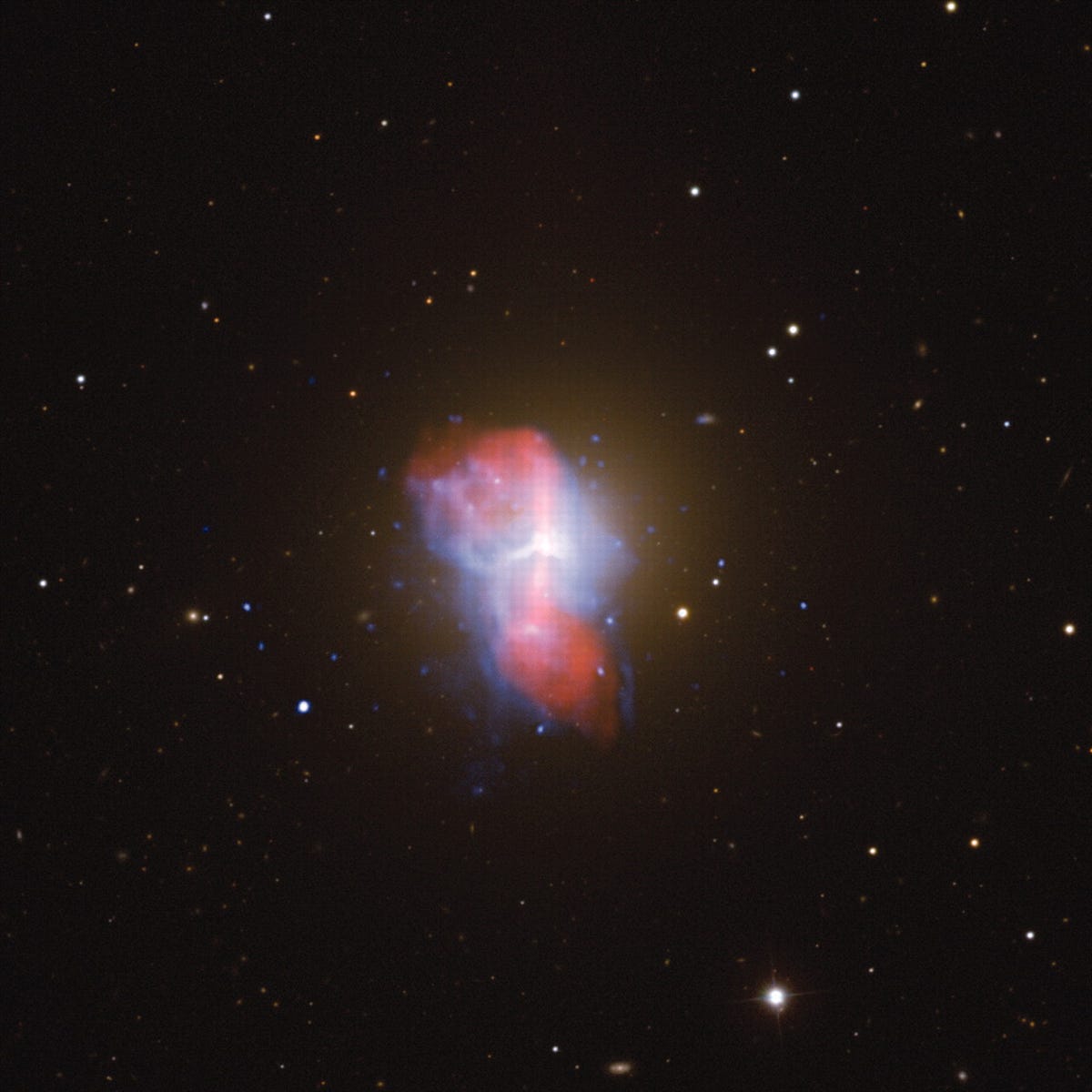
There are so many great images I could present you with to end this post, but truly the most spectacular shot out there is from a team of amateurs at Capella Observatory, showing the full glory of Markarian’s Chain, with M84 on prominent display at the bottom, with close to 100 galaxies visible to keen observers.
Take a look for yourself!
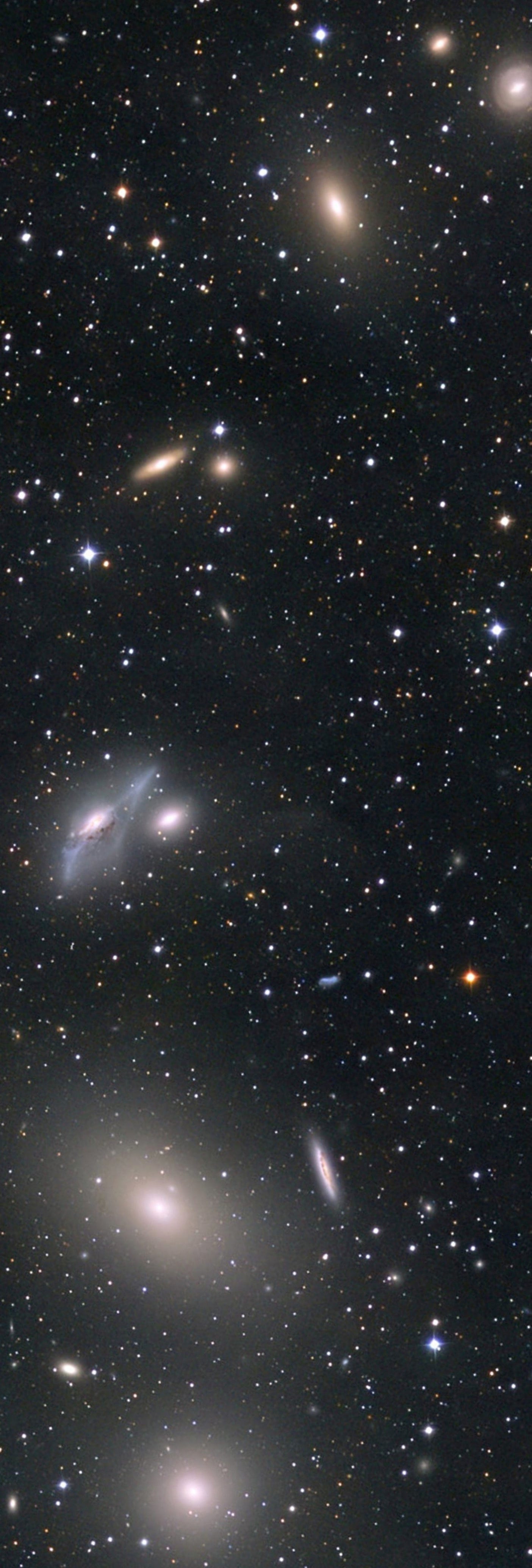
And with that grand tour, we come to the end of another Messier Monday! If you can’t get your fill of the deep sky wonders at your disposal, check out all our previous Messier Mondays below:
- M1, The Crab Nebula: October 22, 2012
- M2, Messier’s First Globular Cluster: June 17, 2013
- M3, Messier’s First Original Discovery: February 17, 2014
- M4, A Cinco de Mayo Special: May 5, 2014
- M5, A Hyper-Smooth Globular Cluster: May 20, 2013
- M7, The Most Southerly Messier Object: July 8, 2013
- M8, The Lagoon Nebula: November 5, 2012
- M10, A Perfect Ten on the Celestial Equator: May 12, 2014
- M11, The Wild Duck Cluster: September 9, 2013
- M12, The Top-Heavy Gumball Globular: August 26, 2013
- M13, The Great Globular Cluster in Hercules: December 31, 2012
- M15, An Ancient Globular Cluster: November 12, 2012
- M18, A Well-Hidden, Young Star Cluster: August 5, 2013
- M20, The Youngest Star-Forming Region, The Trifid Nebula: May 6, 2013
- M21, A Baby Open Cluster in the Galactic Plane: June 24, 2013
- M25, A Dusty Open Cluster for Everyone: April 8, 2013
- M29, A Young Open Cluster in the Summer Triangle: June 3, 2013
- M30, A Straggling Globular Cluster: November 26, 2012
- M31, Andromeda, the Object that Opened Up the Universe: September 2, 2013
- M32, The Smallest Messier Galaxy: November 4, 2013
- M33, The Triangulum Galaxy: February 25, 2013
- M34, A Bright, Close Delight of the Winter Skies: October 14, 2013
- M36, A High-Flying Cluster in the Winter Skies: November 18, 2013
- M37, A Rich Open Star Cluster: December 3, 2012
- M38, A Real-Life Pi-in-the-Sky Cluster: April 29, 2013
- M39, The Closest Messier Original: November 11, 2013
- M40, Messier’s Greatest Mistake: April 1, 2013
- M41, The Dog Star’s Secret Neighbor: January 7, 2013
- M42, The Great Orion Nebula: February 3, 2014
- M44, The Beehive Cluster / Praesepe: December 24, 2012
- M45, The Pleiades: October 29, 2012
- M46, The ‘Little Sister’ Cluster: December 23, 2013
- M47, A Big, Blue, Bright Baby Cluster: December 16, 2013
- M48, A Lost-and-Found Star Cluster: February 11, 2013
- M49, Virgo’s Brightest Galaxy: March 3, 2014
- M50, Brilliant Stars for a Winter’s Night: December 2, 2013
- M51, The Whirlpool Galaxy: April 15th, 2013
- M52, A Star Cluster on the Bubble: March 4, 2013
- M53, The Most Northern Galactic Globular: February 18, 2013
- M56, The Methuselah of Messier Objects: August 12, 2013
- M57, The Ring Nebula: July 1, 2013
- M58, The Farthest Messier Object (for now): April 7, 2014
- M59, An Elliptical Rotating Wrongly: April 28, 2014
- M60, The Gateway Galaxy to Virgo: February 4, 2013
- M61, A Star-Forming Spiral: April 14, 2014
- M63, The Sunflower Galaxy: January 6, 2014
- M64, The Black Eye Galaxy: February 24, 2014
- M65, The First Messier Supernova of 2013: March 25, 2013
- M66, The King of the Leo Triplet: January 27, 2014
- M67, Messier’s Oldest Open Cluster: January 14, 2013
- M68, The Wrong-Way Globular Cluster: March 17, 2014
- M71, A Very Unusual Globular Cluster: July 15, 2013
- M72, A Diffuse, Distant Globular at the End-of-the-Marathon: March 18, 2013
- M73, A Four-Star Controversy Resolved: October 21, 2013
- M74, The Phantom Galaxy at the Beginning-of-the-Marathon: March 11, 2013
- M75, The Most Concentrated Messier Globular: September 23, 2013
- M77, A Secretly Active Spiral Galaxy: October 7, 2013
- M78, A Reflection Nebula: December 10, 2012
- M79, A Cluster Beyond Our Galaxy: November 25, 2013
- M81, Bode’s Galaxy: November 19, 2012
- M82, The Cigar Galaxy: May 13, 2013
- M83, The Southern Pinwheel Galaxy, January 21, 2013
- M84, The Galaxy at the Head-of-the-Chain, May 26, 2014
- M85, The Most Northern Member of the Virgo Cluster, February 10, 2014
- M86, The Most Blueshifted Messier Object, June 10, 2013
- M87, The Biggest One of them All, March 31, 2014
- M88, A Perfectly Calm Spiral in a Gravitational Storm, March 24, 2014
- M90, The Better-You-Look, The Better-It-Gets Galaxy, May 19, 2014
- M92, The Second Greatest Globular in Hercules, April 22, 2013
- M93, Messier’s Last Original Open Cluster, January 13, 2014
- M94, A double-ringed mystery galaxy, August 19, 2013
- M95, A Barred Spiral Eye Gazing At Us, January 20, 2014
- M96, A Galactic Highlight to Ring in the New Year, December 30, 2013
- M97, The Owl Nebula, January 28, 2013
- M98, A Spiral Sliver Headed Our Way, March 10, 2014
- M99, The Great Pinwheel of Virgo, July 29, 2013
- M101, The Pinwheel Galaxy, October 28, 2013
- M102, A Great Galactic Controversy: December 17, 2012
- M103, The Last ‘Original’ Object: September 16, 2013
- M104, The Sombrero Galaxy: May 27, 2013
- M105, A Most Unusual Elliptical: April 21, 2014
- M106, A Spiral with an Active Black Hole: December 9, 2013
- M108, A Galactic Sliver in the Big Dipper: July 22, 2013
- M109, The Farthest Messier Spiral: September 30, 2013
And come back next week for another star-filled delight of the night sky, only here on Messier Monday!
Enjoyed this? Leave a comment on the Starts With A Bang forum at Scienceblogs!





